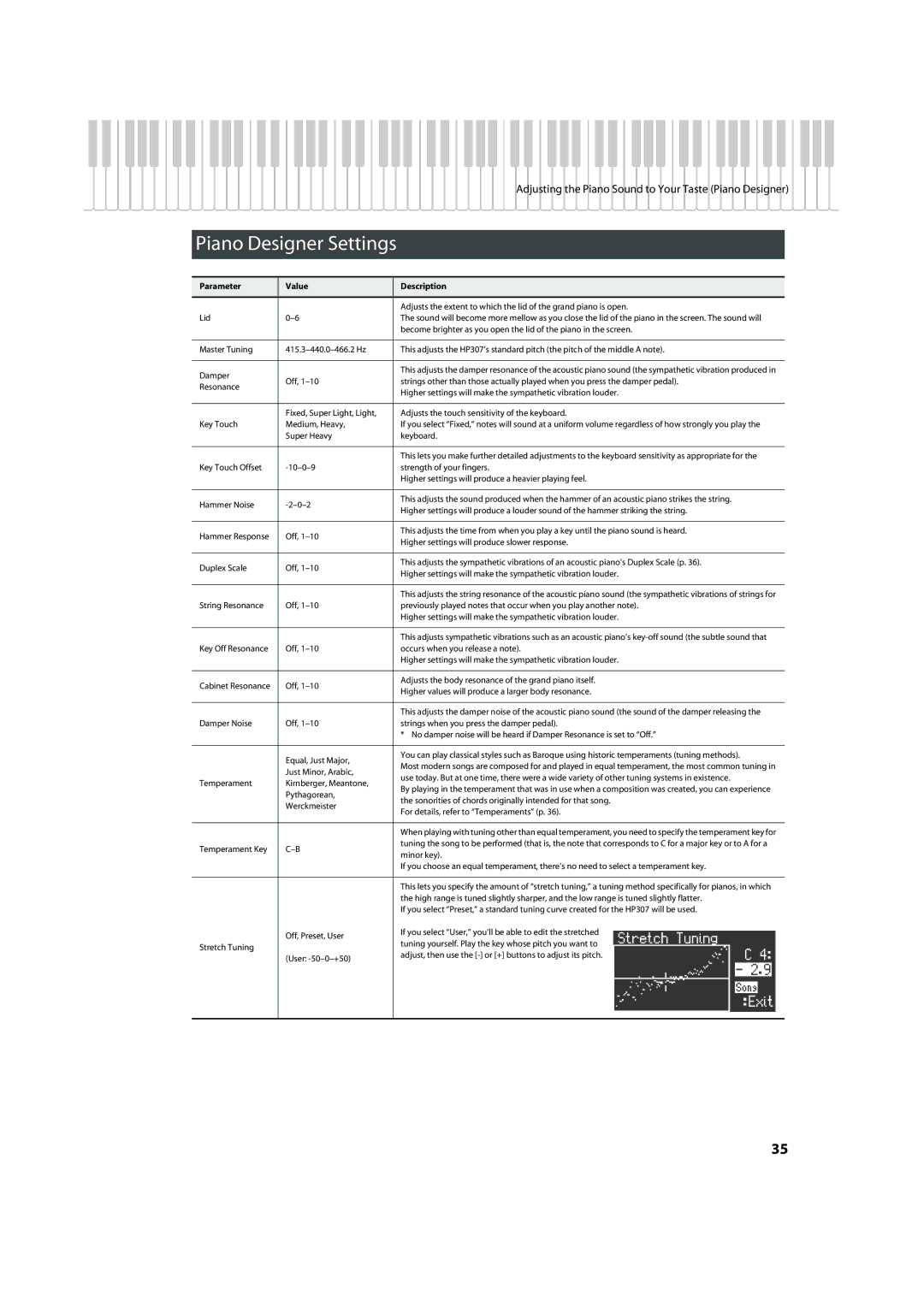
Adjusting the Piano Sound to Your Taste (Piano Designer)
Piano Designer Settings
Parameter | Value | Description | ||
|
|
|
| |
|
| Adjusts the extent to which the lid of the grand piano is open. | ||
Lid | The sound will become more mellow as you close the lid of the piano in the screen. The sound will | |||
|
| become brighter as you open the lid of the piano in the screen. | ||
|
|
|
| |
Master Tuning | This adjusts the HP307’s standard pitch (the pitch of the middle A note). | |||
|
|
|
| |
Damper |
| This adjusts the damper resonance of the acoustic piano sound (the sympathetic vibration produced in | ||
Off, | strings other than those actually played when you press the damper pedal). | |||
Resonance | ||||
| Higher settings will make the sympathetic vibration louder. | |||
|
| |||
|
|
|
| |
| Fixed, Super Light, Light, | Adjusts the touch sensitivity of the keyboard. | ||
Key Touch | Medium, Heavy, | If you select “Fixed,” notes will sound at a uniform volume regardless of how strongly you play the | ||
| Super Heavy | keyboard. | ||
|
|
|
| |
|
| This lets you make further detailed adjustments to the keyboard sensitivity as appropriate for the | ||
Key Touch Offset | strength of your fingers. | |||
|
| Higher settings will produce a heavier playing feel. | ||
|
|
|
| |
Hammer Noise | This adjusts the sound produced when the hammer of an acoustic piano strikes the string. | |||
Higher settings will produce a louder sound of the hammer striking the string. | ||||
|
| |||
|
|
|
| |
Hammer Response | Off, | This adjusts the time from when you play a key until the piano sound is heard. | ||
Higher settings will produce slower response. | ||||
|
| |||
|
|
|
| |
Duplex Scale | Off, | This adjusts the sympathetic vibrations of an acoustic piano’s Duplex Scale (p. 36). | ||
Higher settings will make the sympathetic vibration louder. | ||||
|
| |||
|
|
|
| |
|
| This adjusts the string resonance of the acoustic piano sound (the sympathetic vibrations of strings for | ||
String Resonance | Off, | previously played notes that occur when you play another note). | ||
|
| Higher settings will make the sympathetic vibration louder. | ||
|
|
|
| |
|
| This adjusts sympathetic vibrations such as an acoustic piano’s | ||
Key Off Resonance | Off, | occurs when you release a note). | ||
|
| Higher settings will make the sympathetic vibration louder. | ||
|
|
|
| |
Cabinet Resonance | Off, | Adjusts the body resonance of the grand piano itself. | ||
Higher values will produce a larger body resonance. | ||||
|
| |||
|
|
|
| |
|
| This adjusts the damper noise of the acoustic piano sound (the sound of the damper releasing the | ||
Damper Noise | Off, | strings when you press the damper pedal). | ||
|
| * No damper noise will be heard if Damper Resonance is set to “Off.” | ||
|
|
|
| |
| Equal, Just Major, | You can play classical styles such as Baroque using historic temperaments (tuning methods). | ||
| Most modern songs are composed for and played in equal temperament, the most common tuning in | |||
| Just Minor, Arabic, | |||
| use today. But at one time, there were a wide variety of other tuning systems in existence. | |||
Temperament | Kirnberger, Meantone, | |||
By playing in the temperament that was in use when a composition was created, you can experience | ||||
| Pythagorean, | |||
| the sonorities of chords originally intended for that song. | |||
| Werckmeister | |||
| For details, refer to “Temperaments” (p. 36). | |||
|
| |||
|
|
|
| |
|
| When playing with tuning other than equal temperament, you need to specify the temperament key for | ||
Temperament Key | tuning the song to be performed (that is, the note that corresponds to C for a major key or to A for a | |||
minor key). | ||||
|
| |||
|
| If you choose an equal temperament, there’s no need to select a temperament key. | ||
|
|
|
| |
|
| This lets you specify the amount of “stretch tuning,” a tuning method specifically for pianos, in which | ||
|
| the high range is tuned slightly sharper, and the low range is tuned slightly flatter. | ||
|
| If you select “Preset,” a standard tuning curve created for the HP307 will be used. | ||
| Off, Preset, User | If you select “User,” you’ll be able to edit the stretched |
| |
| tuning yourself. Play the key whose pitch you want to |
| ||
Stretch Tuning |
|
| ||
| adjust, then use the |
| ||
| (User: |
| ||
|
|
| ||
|
|
|
| |
35
